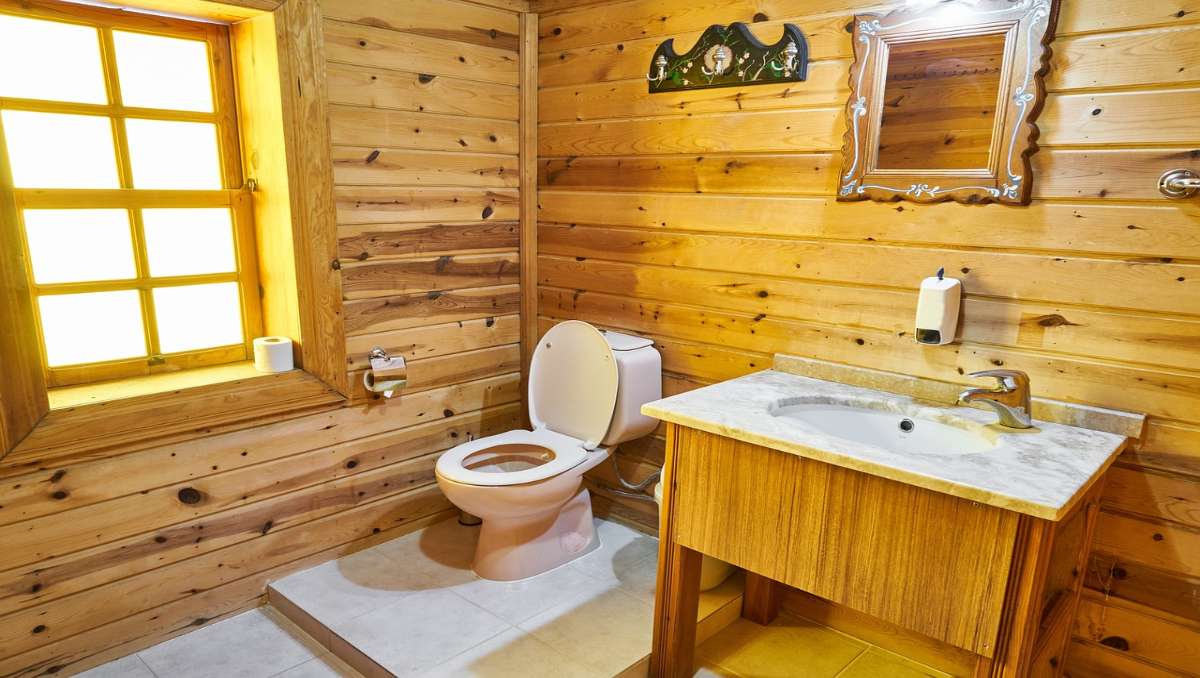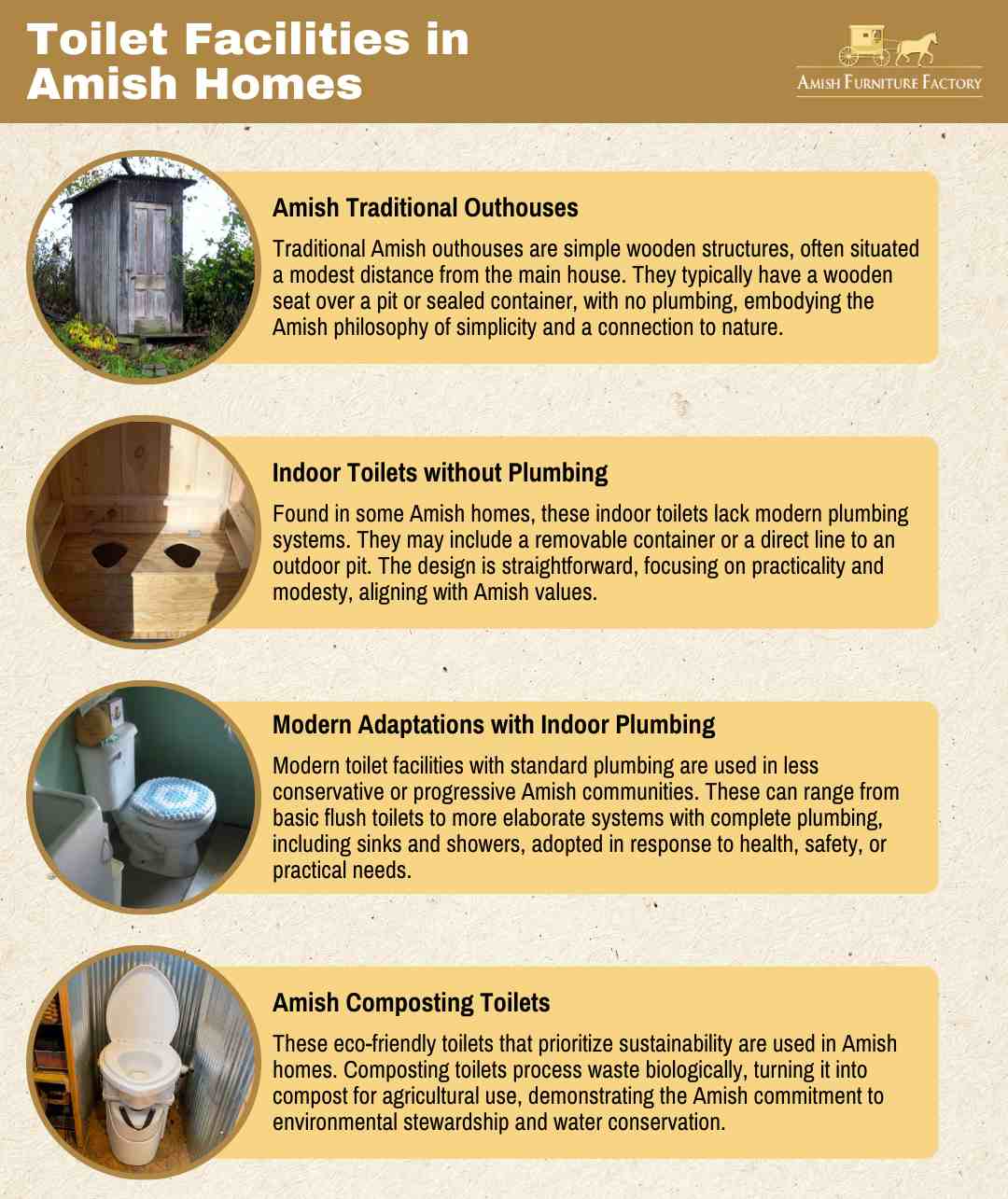
In a world dominated by high-tech solutions, the Amish community holds steadfast to their traditional ways, casting a unique light on everyday tasks. Among these, their approach to something as basic as toilet facilities opens a window into a different way of life.
The Amish’s toilet practices reflect simplicity and environmental care. They predominantly use traditional outhouses, with some adopting indoor or composting toilets, balancing tradition with modern health needs and sustainability.
Diving into the Amish community’s unique lifestyle, this article unravels the intriguing aspects of their toilet practices, offering a deeper understanding of how they navigate daily necessities in a world that often takes modern conveniences for granted.
Understanding Amish Bathroom Practices
Understanding these aspects of Amish bathroom practices offers a unique perspective into a community that values simplicity, environmental consciousness, and religious adherence, even in the most private aspects of daily life.
Simple and Functional
For the Amish, bathroom facilities are about simplicity and functionality. Common in many communities, outhouses are basic structures devoid of modern plumbing.
They’re typically built with modesty and practicality in mind, a stark contrast to the often luxurious bathrooms in the contemporary world. These facilities directly manifest the Amish philosophy that less is more and that a simple life is virtuous.
Environmental Friendly
The Amish are also deeply committed to living in harmony with nature, which extends to their bathroom habits. They often use environmentally friendly practices, like composting toilet waste, instead of sewage systems.
This method recycles waste effectively and aligns with their ethos of minimizing their environmental footprint. By turning human waste into compost, they deal with their refuse responsibly and contribute positively to their agricultural needs.
Religious and Cultural
Amish bathroom practices are also influenced by their religious beliefs. Their avoidance of modern conveniences, including plumbing and electricity, is rooted in a desire to live a humble life focused on community and faith.
In the privacy of their bathrooms, the Amish community’s choices are intimately linked to their religious and cultural ethos. They favor using outhouses, composting toilets, and other non-electric sanitation solutions as their dedication to a lifestyle free from the complexities of sophisticated technology.
Community Variations
As established, Amish practices can vary significantly from one community to another. While some may strictly adhere to outhouses, others might adopt more modern solutions like indoor toilets without plumbing, especially where local health regulations necessitate such adaptations.
This variation underscores the Amish community’s ability to balance traditional values with practical needs and external pressures.
Toilet Facilities in Amish Homes
The following are the types of toilet facilities the Amish use. They are simple yet practical and serve as a testament to their values and way of life.

Amish Traditional Outhouses
Traditional outhouses in Amish communities are typically constructed of wood, with a design emphasizing functionality and durability. Situated a modest distance from the main house, they offer privacy while maintaining a connection to the natural surroundings.
The interior of a traditional outhouse is Spartan, often consisting of a wooden seat with a hole that opens over a deep pit or a sealed container. This design eliminates the need for plumbing, aligning with the Amish philosophy of living without modern conveniences.
The pits or containers are regularly serviced to ensure sanitary conditions and prevent environmental contamination.
Externally, these Amish outhouses may vary in appearance, from plain, unpainted wood to structures painted in colors that blend with the environment or match the main house.
Despite their simple construction, they are built to withstand the elements and time, often featuring weather-resistant roofs and sturdy door hinges.
Indoor Toilets in Some Amish Homes
While traditional outhouses are common, some Amish homes have incorporated indoor toilets, particularly in less conservative communities. These indoor facilities mark a subtle shift towards modern convenience while maintaining core Amish values.
Unlike typical urban toilets, some indoor units often lack modern plumbing systems. Instead, they may feature a removable container or a direct line to an outdoor pit, embodying a practical approach to waste management.
On the other hand, less conservative or more progressive communities have adopted indoor plumbing and standard toilets. These modern facilities range from basic flush toilets to more elaborate systems with complete plumbing, including sinks and showers in some instances.
The design of these toilets is usually straightforward and functional, with an emphasis on modesty and simplicity. The materials used are often similar to those found in the rest of the home, such as plain wood, maintaining a cohesive aesthetic with the household’s overall style.
In some cases, these indoor toilets have been adopted in response to health and safety regulations or practical considerations, such as the challenges of accessing an outhouse during harsh weather conditions. This adaptation demonstrates the Amish community’s ability to balance their traditional practices and the practical needs of modern living.
Amish Composting Toilets
Some Amish households have adopted composting toilets in their continuous effort to live sustainably and in harmony with nature. These toilets combine traditional Amish values with innovative, eco-friendly technology.
Composting toilets process human waste through a biological composting action, transforming it into a nutrient-rich soil additive. Amish communities value this method for its water conservation benefits and alignment with their environmental ethos.
The design of these composting toilets in Amish homes is typically plain, focusing on functionality and environmental efficiency. They are often manually operated, requiring no electricity or plumbing. The waste is treated with natural materials like sawdust or peat moss, facilitating composting and minimizing odors.
Composting toilets underscore the Amish commitment to a lifestyle that is both sustainable and self-reliant. By turning waste into a resource for enriching the soil, they embody the Amish philosophy of stewardship over the land.
Use of Toilet Paper Among the Amish

In the Amish community’s approach to using toilet paper, there is a distinctive balance between traditional practices and the need for modern hygiene. Many traditional Amish communities view toilet paper as an indulgence, prioritizing essential needs like food and clothing.
This section will delve into how they reconcile these long-standing traditions with the practical aspects of contemporary sanitary practices, providing a deeper understanding of the Amish way of life in a dynamic world.
Alternatives to Toilet Paper in Traditional Amish Practice
In many traditional Amish communities, manufactured toilet paper is seen as a luxury item. Instead, they use the following alternatives:
- Leaves: Naturally available and biodegradable, leaves are common in many rural settings.
- Corn Cobs: Historically used in many rural areas, including Amish communities, corn cobs are a readily available resource after harvesting.
- Newspapers: Old newspapers are repurposed as a practical and accessible alternative.
- Catalog Pages: Pages from catalogs, similar to newspapers, are used for their availability and practicality.
These materials are chosen not just for their availability and practicality, but also for the Amish principle of resourcefulness and simplicity. This practice also reflects their approach to waste reduction and environmental conservation.
Adoption of Conventional Toilet Paper in Progressive Amish Groups
While traditional Amish groups have long favored alternative items for sanitation purposes, many communities, especially those less stringent about modernization, are beginning to embrace conventional toilet paper.
This change is particularly noticeable in communities that engage more frequently with non-Amish society, where exposure to and interaction with mainstream practices tend to be higher.
Another factor in this trend is the influence of younger generations within these communities. Younger Amish, often more exposed to external cultures and practices, are at the forefront of integrating modern conveniences into their lifestyle.
Interplay of Amish Cultural Beliefs and Modern Hygiene Standards
In terms of sanitation, traditional Amish practices often eschew modern conveniences like manufactured toilet paper. However, the Amish are not a monolithic community; their practices can vary significantly across different groups, each interpreting and balancing their cultural and religious principles with practical considerations.
While many Amish continue to uphold traditional methods, there is an understanding within the community that modern hygiene practices can coexist with these principles. This understanding reflects a recognition of the health and hygiene benefits that certain contemporary practices can offer.
Therefore, while maintaining their overarching commitment to a simple, modest lifestyle, some Amish groups have shown flexibility in adopting modern hygiene practices when they perceive them to be beneficial and not in direct conflict with their core values.
Environmental and Health Considerations

Through these environmental and health considerations, the Amish demonstrate how traditional practices coexist with a commitment to sustainability and public health. Their approach offers valuable insights into living responsibly and harmoniously with the natural world.
Environmental Impact of Amish Sanitation
The environmental impact of Amish sanitation practices reflects their broader commitment to an eco-friendly lifestyle. Beyond their well-known use of outhouses and composting toilets, these practices encompass a holistic approach to managing waste and conserving resources.
- Eco-Friendly Waste Management
The Amish method of waste management, mainly through composting toilets, is a crucial example of their sustainable practices. These toilets decompose human waste naturally, converting it into compost.
This compost enriches agricultural soil, closing the nutrient loop and reducing the need for chemical fertilizers. By recycling waste this way, the Amish turn what would be a pollutant in conventional sewage systems into a valuable resource for their farms.
- Water Conservation
Another significant aspect of Amish sanitation is water conservation. Traditional outhouses and composting toilets require significantly less water than standard plumbing systems.
In a world where water scarcity is an increasing concern, these practices exemplify a model of efficient water use. By minimizing water consumption in sanitation, the Amish preserve this vital resource.
- Reduced Environmental Footprint
The combined effect of these practices results in a markedly reduced environmental footprint for Amish communities. Unlike conventional sewage systems, which can contribute to water pollution and require energy-intensive treatment processes, the Amish approach to sanitation avoids these environmental pitfalls.
This sustainable model benefits their immediate surroundings and contributes to broader environmental conservation efforts.
- Integration with Agricultural Practices
Amish sanitation methods are not isolated but integrated into their approach to farming and living off the land. The use of composted waste as fertilizer is a direct link between their sanitation practices and agricultural productivity.
This integration demonstrates a sustainable way of living where every aspect of life is harmonized with the natural environment.
Health Aspects in Amish Communities
While environmental sustainability is a priority in Amish communities, health and hygiene are crucial, especially in sanitation practices. The design and maintenance of their toilet facilities, such as outhouses and composting systems, are carefully planned to minimize health risks. This mirrors findings from a study on coastal Bangladesh’s sanitation, where knowledge and practices significantly impacted health outcomes.
- Design for Hygiene
The design of Amish toilet facilities, particularly outhouses, often includes features to limit direct contact with waste and to reduce the risk of contamination.
This might involve strategically placed vents, deep pits, or sealed containers in composting toilets. Such designs help mitigate the spread of bacteria and pathogens that can lead to health issues.
- Maintenance and Cleaning Regimen
Regular and thorough cleaning is a vital part of Amish sanitation practices. This regimen includes periodically removing waste from composting toilets and cleaning outhouses.
Such maintenance is essential in preventing the build-up of harmful pathogens and ensuring a hygienic environment. The Amish are meticulous in these routines, understanding the direct link between sanitation and health.
- Proper Waste Disposal
In Amish communities, waste disposal methods are executed meticulously to prevent environmental and health hazards. This practice is aligned with insights from the Bangladesh study, where proper waste disposal was linked to reduced health risks.
Both communities understand the importance of responsible waste management, whether through composting or careful disposal.
- Health Education and Practices
In addition to physical measures, education about hygiene and sanitation is an integral part of Amish communities. This includes understanding the importance of handwashing, safe food handling, and other hygiene practices, especially after using toilet facilities.
Such education is crucial in communities where modern sanitation facilities are not used, as it helps prevent the spread of illnesses.
Balancing Tradition with Modern Health Standards
The Amish community’s approach to sanitation is a fine example of how they balance their traditional values with modern health standards. In certain instances, particularly when local health regulations mandate, the Amish are willing to adapt their practices.
This adaptation highlights their ability to uphold their core principles while ensuring their community members’ health and safety.
- Adapting to Health Regulations
In areas where regulations are more stringent regarding sanitation and public health, the Amish have shown flexibility in adopting practices that comply with these rules.
This may involve introducing more modern toilet facilities that meet health codes yet are designed and utilized in ways that align with their simplicity and environmental care values.
- Modern Facilities and Amish Values
When integrating modern toilet facilities, the Amish do so thoughtfully, ensuring that these adaptations do not compromise their commitment and values.
For example, some Amish communities might use indoor plumbing systems that are more basic and less reliant on electricity, or they might adopt water-saving toilets that align with their principles of conservation and stewardship of natural resources.
- Health and Community Well-being
The health and well-being of the community are paramount in these adaptations. Adopting certain modern sanitary practices demonstrates that the Amish understand community health is critical to communal living.
These adaptations are seen as necessary to protect the health of all community members, especially in preventing the spread of diseases.
- A Balance of Old and New
The Amish carefully assess which modern practices can be integrated into their lifestyle without diluting their cultural identity. This careful consideration ensures that while they may adopt a few innovations from the non-Amish society, they remain distinctly Amish in their way of life.
Historical Context of Toilet Paper and Amish Practices
Through the lens of toilet paper’s history, we gain a unique perspective on the Amish community’s thoughtful integration of modern conveniences with their deeply held values.

The Evolution of Toilet Paper
The evolution of toilet paper is a remarkable aspect of hygiene history, mirroring broader societal changes. Before its advent, various natural materials served as cleaning aids for personal hygiene.
Leaves, rags, wool, and water were widely used, demonstrating humanity’s resourcefulness in using available resources. Each culture had unique methods, influenced by the natural environment and social customs.
In 1857, the world saw a pivotal moment in hygiene practices with the introduction of modern toilet paper by Joseph Gayetty. This innovation marked a significant transformation in how societies approached personal cleanliness.
Initially, toilet paper was a luxury item, accessible only to the affluent due to its cost and limited availability. It represented a significant departure from traditional materials, offering a new level of convenience and effectiveness in personal hygiene.
Over time, as production methods improved and availability increased, toilet paper transitioned from an exclusive commodity to an everyday household necessity. This shift was not just a change in consumer goods but also reflected a broader societal move towards modernization and an increased focus on hygiene and sanitation.
Amish Response to Modern Sanitation
While mainstream society quickly embraced toilet paper’s convenience and hygiene benefits, many Amish communities continued using traditional materials like leaves, rags, or corn cobs for personal sanitation.
This adherence to traditional practices in the face of modern alternatives reflects the community’s commitment to Amish lifestyle that prioritizes spiritual and communal values over material convenience.
The decision to forego toilet paper by some of the more traditional communities is not merely a matter of habit or resistance to change but a manifestation of their dedication to a way of life that fosters a closer community, a stronger connection to their environment, and a more meaningful spiritual existence.
Amish Bathroom Hygiene and Public Perception
The Amish bathroom practices, often misunderstood, highlight a sophisticated approach to living simply yet responsibly, with a keen awareness of health and environmental implications.
Maintaining Cleanliness
Despite the simplicity of their bathroom facilities, cleanliness and hygiene are priorities in the Amish community. Regular cleaning and maintenance of outhouses and other toilet facilities are customary to prevent health hazards.
The Amish are conscientious about preventing contamination and disease spread, even with limited resources. This diligence ensures that their traditional methods effectively meet the community’s health and hygiene needs.
Public Misconceptions
There are common misconceptions about Amish bathroom hygiene, mainly due to a lack of understanding of their practices. Outsiders might assume that the absence of modern plumbing equates to poor hygiene standards.
However, this isn’t the case; the Amish have developed efficient, albeit traditional, methods for maintaining cleanliness. Their practices reflect a deep understanding of basic sanitary principles, adapted to fit within their cultural and religious framework.
The Intersection of Tradition and Health
The Amish approach to bathroom hygiene carefully balances tradition and health. While these people adhere to their cultural norms of simplicity and environmental consciousness, they also recognize the importance of maintaining good hygiene for community well-being.
This balance is a testament to their ability to navigate the challenges their lifestyle choices pose, ensuring that their health and hygiene standards are not compromised.
Modern Adaptations and Innovations
Looking at the modern adaptations and innovations within Amish bathroom practices, we see a community anchored in tradition and responsive to change. These adaptations reveal the Amish’s pragmatic side, as they find ways to integrate beneficial modern solutions while staying true to their fundamental values.
Introduction of Modern Plumbing in Some Communities
In some Amish communities, modern plumbing facilities have gradually been introduced. Practical needs, health concerns, or compliance with local regulations often drive this change.
While still rare, these modern adaptations are implemented in a way that respects the Amish principles of simplicity and modesty. For instance, some homes might have indoor toilets without the extensive plumbing systems typical in non-Amish homes.
Use of Eco-friendly Toilet Technologies
Recognizing the need for environmental conservation, some Amish have begun to explore eco-friendly toilet technologies. Composting toilets, for example, have found a place in some Amish homes, offering an efficient way to manage waste while reducing water usage.
These technologies align well with the Amish ethos of living sustainably and minimizing their ecological footprint.
Cultural and Religious Significance
The cultural and religious significance of bathroom practices among the Amish highlights how integral these everyday routines are to their identity and beliefs. These practices are not merely functional choices but are imbued with deeper meanings that reflect the Amish community’s commitment to their faith, values, and the world they inhabit.

Reflection of Humility
Their approach to bathroom facilities shows the Amish belief in living simply and humbly. Their preference for basic, unadorned toilets over more modern, luxurious options physically manifests their religious commitment to lead a modest life.
This simplicity is more than just a matter of practicality. It is also seen as a spiritual discipline, keeping the Amish focused on their faith and community rather than material comforts.
Stewardship of the Earth
Environmental stewardship, an essential aspect of the Amish faith, dramatically influences their bathroom practices. Composting toilets or traditional outhouses reflect their belief in caring for God’s creation.
By adopting methods that minimize waste and conserve natural resources, the Amish express their respect for the environment, which they see as intertwined with their religious duty.
Adaptability Within Cultural Norms
While the Amish are often perceived as resistant to change, their bathroom practices adapt to their cultural norms. This flexibility is a pragmatic response to the realities of health, hygiene, and environmental concerns.
It demonstrates that while their religious and cultural principles remain steadfast, they are willing to make practical adjustments as long as they do not conflict with their core beliefs.
A Glimpse into Amish Life: Understanding Their Approach to Toilets
This article reveals more than just the practicalities of Amish bathroom facilities; it highlights a lifestyle prioritizing sustainability, community values, and thoughtful living.
In their careful balance of tradition and necessary modern adjustments, the Amish offer a unique perspective on maintaining cultural integrity while responding to evolving societal challenges.
As we reflect on their approach to such an essential aspect of daily life, we are reminded of the broader implications of our choices and the potential for integrating simplicity and sustainability into our lives.
